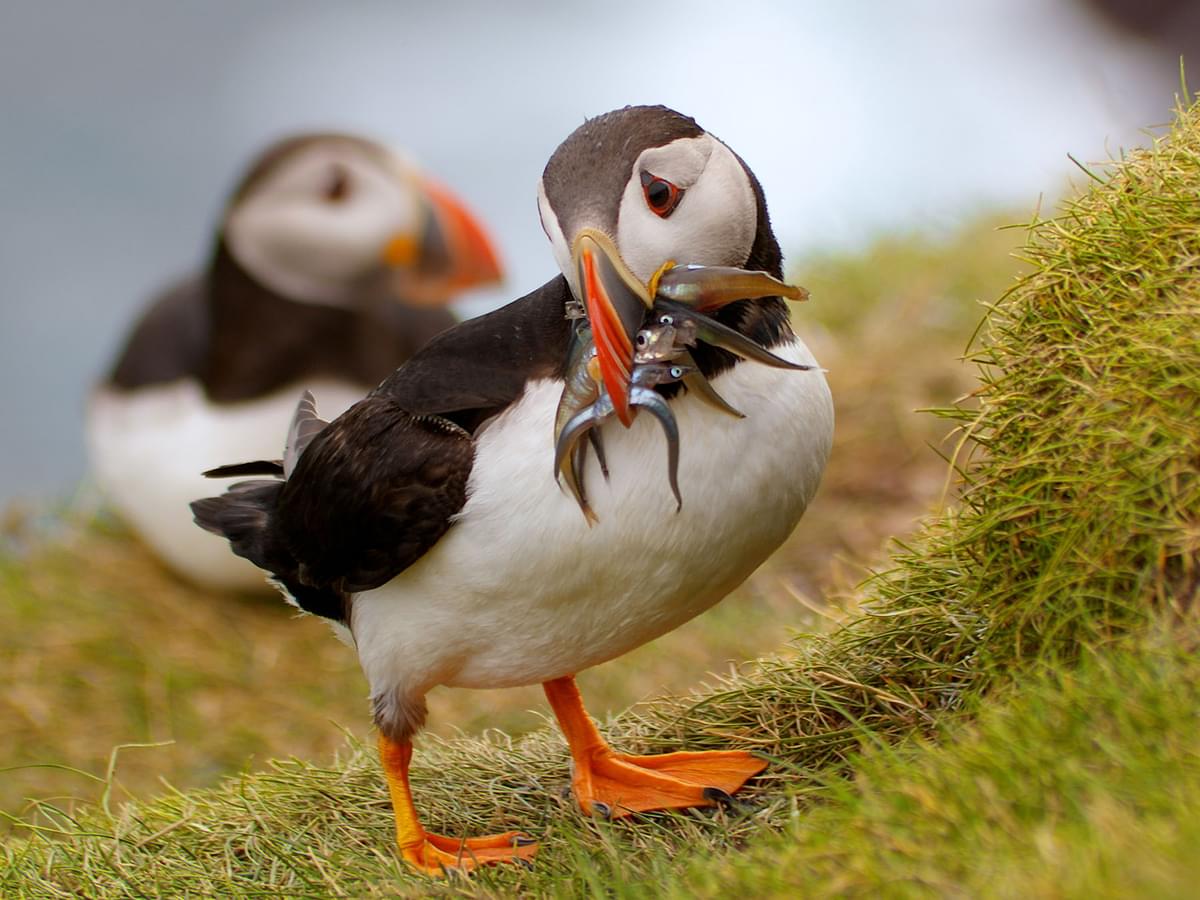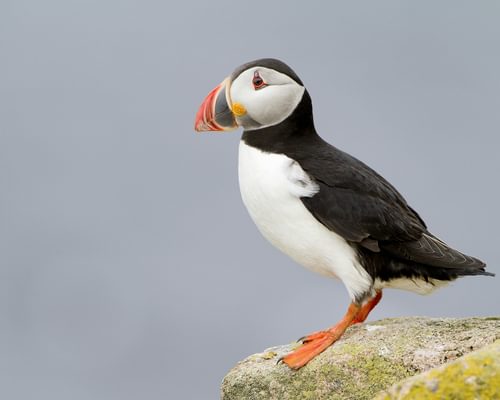The Atlantic Puffin (Fratercula arctica) is one of three seabird species in the Alcidae family. It is the only species from the Atlantic ocean, occurring from the northeast of the United States to Europe and east to the Kara Sea off the Russian Coast.
Have you ever wondered where these delightful seabirds build their nests and raise their young?
Atlantic Puffins nest underground in burrows that they dig themselves or in crevices and caves under boulders in rocky areas. These distinctive birds nest in colonies on islands or above sea cliffs, raising a single chick in the summer each year.
Atlantic Puffins are monogamous birds that usually pair up with the same partner year after year. Depending on latitude and climate, breeding birds will return to their nesting colonies in the spring or summer.
Sadly, hunters decimated many Atlantic Puffin breeding colonies in the 19th century. However, these birds often return to nest in the same rookery where they were born, a habit that has helped conservationists reintroduce them to old abandoned colonies.
Atlantic Puffins lay just one egg each year and only start breeding when they are four or five years old. Such a slow reproductive rate means puffin parents need to take great care, and both parents work together to build the nest, keep the egg warm, and feed the growing chick.
There’s a lot more to discover about the nesting habits of the Atlantic Puffin. Read along to learn all the fascinating facts about these colorful clowns of the sea.

Atlantic Puffin emerging from the nesting burrow in the ground, Skomer Island, UK
Nest Location
Atlantic Puffins nest in colonies in specific locations across the north Atlantic ocean. These rookeries occur from Northern New England to Greenland in the west, and the United Kingdom and Russia in the West. Continue reading to learn more about the Atlantic Puffins breeding range.
Where do Puffins nest?
Puffins breed in colonies on islands and coastal cliffs that can support tens of thousands of breeding pairs. Most of the world's Atlantic Puffins breed in Iceland, but they also nest much closer to home in Islands off the coast of Maine.
Atlantic Puffins also breed at several colonies on islands around the UK and above sea cliffs on the mainland. These birds live year-round in the east but fly well and make long-distance migrations to breed at rookeries in Northeastern Canada and Greenland in the summer.
Do Puffins nest in the same place every year?
Atlantic Puffins usually return to the same nest in the same colony year after year. However, young birds will move to new colonies if theirs becomes overcrowded. Adults reunite to nest with the same partner year after year, although they probably spend the rest of the year apart.
How high are Puffin nests?
Atlantic Puffins build their nests on the ground, although they often select sites at the top of sea cliffs.

Nesting colony of Puffins
Nest Appearance
Puffins do not build typical cup or bowl-shaped nests. These seabirds nest underground, safe from the elements and most predators. Read on to learn more.
What do Puffin nests look like?
Puffin nests are usually not visible because they are built at the end of a tunnel or in a crevice under rocks. Self-excavated nesting tunnels look somewhat like rodent burrows with an entrance diameter of five to seven inches (13 - 18 cm).
How big are Puffin nests?
Puffins can excavate extensive nest burrows. Most tunnels measure about two and a half to three and a half feet long, although some can reach an impressive fifty feet (15 m).

Puffin chick (Puffling) emerging from nesting burrow
Phenology
Puffins are spring/summer-breeding birds. They nest across a wide range of latitudes in temperate and arctic zones where the summer is brief and other times of the year can be extremely cold. Continue reading to learn more about the timing of Atlantic Puffin nesting.
What time of year do Puffins nest?
Atlantic Puffins begin nesting at different times, depending on the local climate. In Maine, for example, nesting begins in March, while in northern colonies, nesting can start as late as mid-June. The same pattern unfolds across the Atlantic, where Puffins start nesting as early as March in Wales.
Continue reading to learn when Atlantic Puffins arrive and begin nesting at various parts of their breeding range:
- Scotland: April
- Norway: April
- Iceland: May
- Greenland: May
- Svalbard: May
How long do Puffins nest for?
Atlantic Puffins get started on digging or repairing an old nest burrow after arriving back at their nesting colonies. The nesting process, from the adult's arrival to the time the chick leaves the nest, lasts about 14 weeks.
Atlantic Puffin nesting timeline:
- Nest construction/repair: 2 - 3 weeks
- Incubation: 36 - 45 days
- Fledging: About 40 days (Up to 83 days in some cases)
What month do Puffins lay eggs?
Puffins lay their eggs between late April and mid-June. Their arrival at the breeding colony and the time when egg laying occurs depends on the colony’s location.

Puffin looking out of the nesting burrow
Nest Construction
Puffins usually excavate their own nests, which is not unusual among seabirds. Read on to learn more.
How do Puffins build their nests?
Atlantic Puffins dig their own nesting burrows using their bills and feet. In some cases, they will use the burrows of other seabirds or mammals. They use their large, colorful beaks to break up the soil and then shovel it backward with their feet.
The tunnel is usually a few feet long and ends in a nest chamber. The adults collect soft materials to line this area before laying the egg. On rocky ground, the birds will nest under boulders or in cracks and crevices that provide a sheltered environment.
What do Puffins use for nesting?
Puffins often build a soft nest inside their tunnel. They make this nest with feathers, grass, and other plant material.
Do male or female Puffins build the nest?
Both male and female Atlantic Puffins work together to excavate their nest burrow. However, males tend to do more of the digging.

Atlantic puffin (Fratercula arctica) getting showered in earth by a hidden puffin digging out an underground nesting burrow, Skomer Island, UK
Puffin Eggs
Atlantic Puffins are dapper little birds, although they hatch from relatively dull eggs. Continue reading to learn more about Puffin eggs.
What do Puffin eggs look like?
Atlantic Puffin eggs are plain white, sometimes with some faint to distinct brown spots. The average size of Puffin eggs varies slightly between colonies, but most eggs are about 2.5 inches (63 mm) long and 1.7 inches (44 mm) across.
How many eggs do Puffins lay?
Atlantic Puffins lay just one egg per year.
Do male Puffins sit on eggs?
Male and female Atlantic Puffins share the incubating duties. The parents take turns, and their shifts are long. Each bird may spend one to two and a half days on the eggs, although they leave briefly to stretch their wings and relieve themselves.

Atlantic Puffin Egg

Young Puffin chick emerging from burrow to meet returning parent
Fledgling and Parental Care
Atlantic Puffins lay just a single egg each year, so they take the utmost care to raise their chick. Both parents take turns brooding the baby for the first nine days after hatching. Keep reading for more fascinating facts.
When do baby Puffins leave the nest?
Atlantic Puffin chicks fledge the nest and become independent when they are 38-44 days old. They are roughly 70% of their adult body mass at this age and fly straight out to sea to avoid land predators like foxes and birds of prey like Peregrine Falcons.
How many broods do Puffins have?
Atlantic Puffins are single-brooded. They lay just one egg during the annual nesting season.

Puffin retuning with a beak full of sand eels to feed the chick
Atlantic Puffin Nesting FAQs
Do Puffins abandon their nests?
Sadly, some Puffins abandon their nests and even their chicks when food sources become scarce. They could also desert their nests when disturbed, so birdwatchers and tourists should observe these birds from a safe distance rather than approach too closely.
Do Puffins nest on the ground?
Atlantic Puffins are ground-nesting birds. However, they build their nests under the ground rather than on the surface. Puffins dig burrows into the soil or nest in crevices in rocky areas.
Where do Puffins nest at night?
Atlantic Puffins usually sleep out on the water at night. However, they may roost on dry land near the colony’s edge. One puffin parent will spend the night incubating the eggs or brooding the chick during the nesting season.
How to attract nesting Puffins?
Atlantic Puffins only nest in established breeding colonies. Conservationists have successfully reintroduced them to islands in the Gulf of Maine by introducing and rearing chicks from other islands. Many of these birds returned when they matured, and the colonies are now back up and running again.

